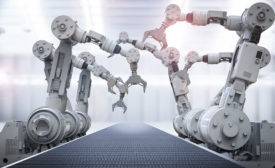Home » Keywords: » robotic trends
Items Tagged with 'robotic trends'
ARTICLES
Report: Global sales of robots hit $16.5B in 2018
Logistics systems, such as autonomous guided vehicles (AGVs) represent 41% of all units sold, followed by inspection and maintenance robots (39%).
September 20, 2019
Study: Robotic process automation software revenue to reach $1.3B in 2019
North America continued to dominate the RPA software market, with a 51% share in 2018.
June 25, 2019
Study: 50,000 warehouses to use robots by 2025
The rapid rate of adoption will be driven by the need for flexible, efficient and automated e-commerce fulfillment.
March 27, 2019
Study: 48% of robots shipped in 2018 were for food, beverage industry
The study shows 35,880 units were shipped in 2018, a 7% increase over 2017.
February 28, 2019
Honeywell, Carnegie Mellon University to develop advanced supply chain robotics, AI solutions for distribution centers
The collaboration will focus on developing a next-generation architecture to control and operate multiple robotic applications.
August 28, 2018
Report: Advanced use of automation in Europe to double by 2020
The research reveals RPA budgets in Europe increased on average by 9% in the last year, significantly ahead of the average increase for general IT spending.
June 20, 2018
Study: Warehousing, logistics robot shipments will reach 620,000 units annually by 2021
Mobile robot platforms and industrial robot manipulators will drive the largest market growth during the forecast period.
December 18, 2017
Study: Global food robotics market worth $2,159.3M by 2022
Europe holds the major share in the global food robotics market, followed by North America and Asia-Pacific.
November 27, 2017
Top 6 robotic applications in food manufacturing
recent developments in sensing and soft gripping make it possible for robots to handle many raw foods.
August 10, 2017
Get our new eMagazine delivered to your inbox every month.
Stay in the know on the latest food and beverage manufacturing markets.
SUBSCRIBE TODAYCopyright ©2024. All Rights Reserved BNP Media.
Design, CMS, Hosting & Web Development :: ePublishing

